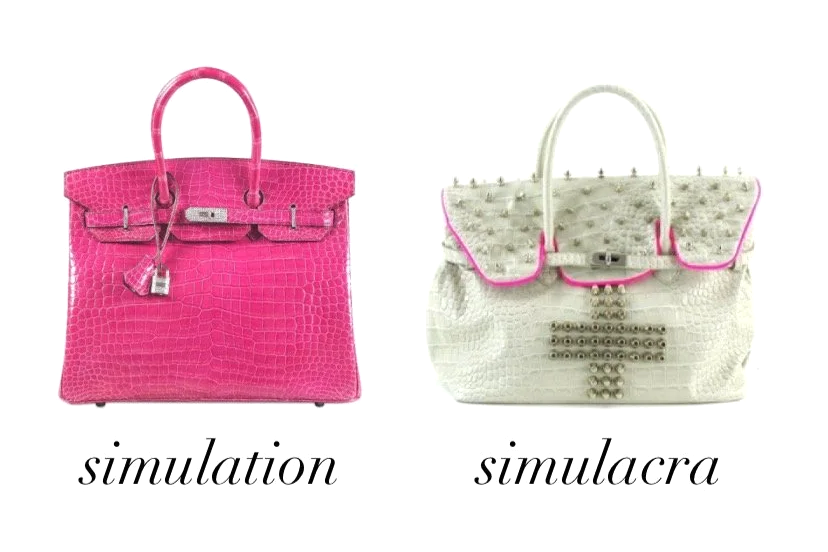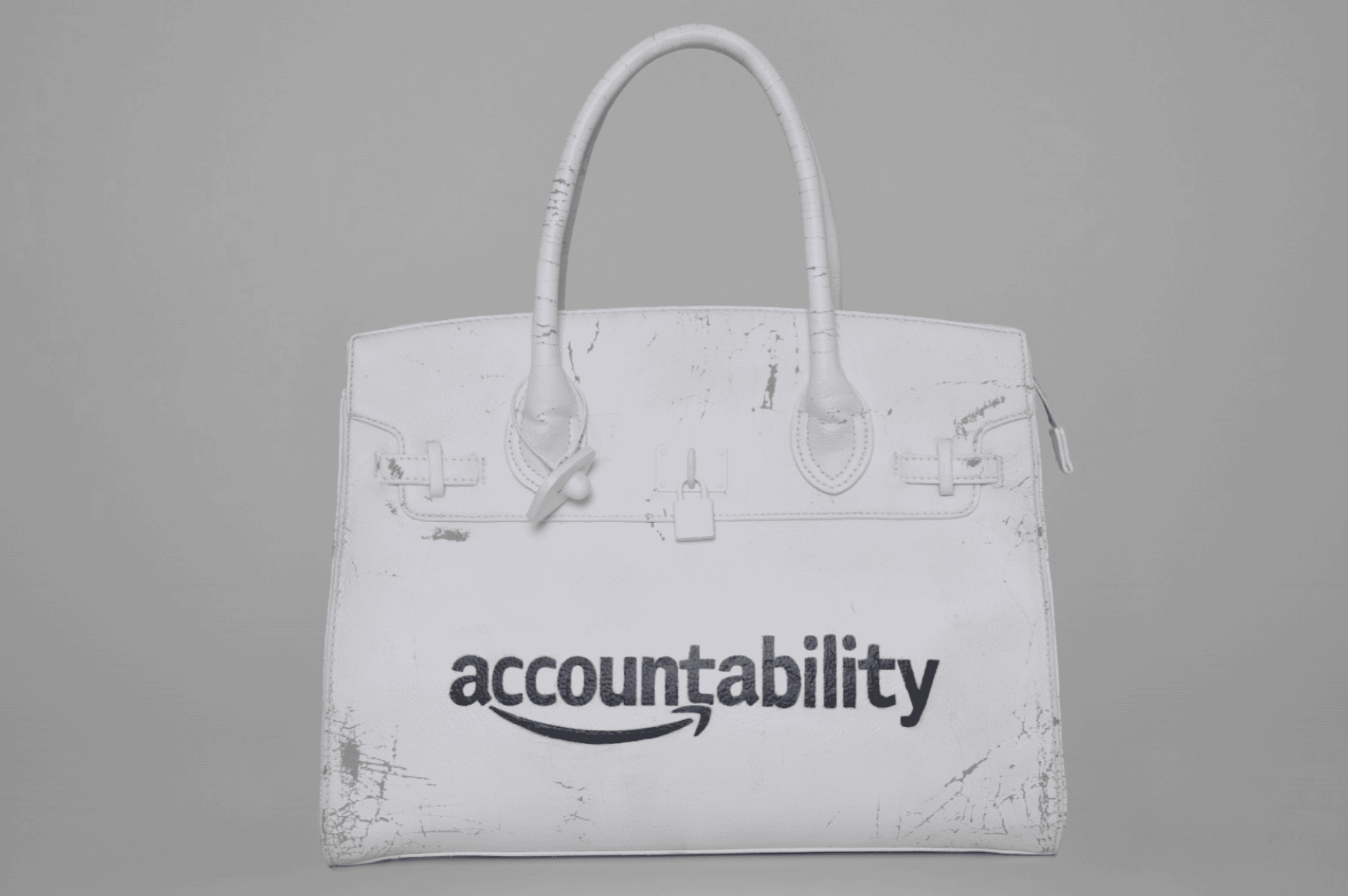Are you for real?
Firkins, counterfeit culture, and the disillusionment of luxury
@__anemonia on Instagram
The other week, while I was taking solace with one of my best friends in Milan, I held a Firkin for the first time. Availing myself of her Italian hospitality (and her Italian wardrobe) I beelined straight for a Silvian Heach studded Firkin as soon as the words, “you can borrow whatever you’d like” left her mouth. It always feels so inexplicably chic to carry around a big ass bag, and this one was no exception. All weekend I revelled in its counterfeit, cross-studded glory. Strutting around the city – bag in tow – I felt like a million euros.
It’s ironic then, that this bag is the ‘simulacra’ to the Hermés Birkin’s ‘simulation’ as philosopher Jean Beaudrillard might put it. An aesthetic subversion of high luxury – it’s a part of a trend that’s been inundating my feed more and more. While the ‘fashion set’ usually turns up its nose at fakes, I’ve never seen a counterfeit so embraced as the Firkin. Maybe I’ve watched too many of LoveLuxury’s guiltily pleasurable TikToks, but it felt like there was a mass aspiration towards the Birkin; now the pendulum has swung.
The Firkin in question
Really, Firkins are everywhere. While Berlin-based brand Namilia was threatened with an Hermes lawsuit in 2023 for its Birkin-inspired collection, that didn’t seem to stop anyone. Buzzy, small brands like Praying and Parallel Studio have also jumped on the Firkin train amidst Walmart’s Wirkins, Mulberry’s Bayswater bag, and Balenciaga’s Belair bag. It’s being duped into oblivion. Not to mention the abundance of secondhand ‘no brand’ Firkins, which often feature faux leather, camo, neon, or just a tasteful ‘tackiness’ at large. What’s all this about, then?
Before I go any further, let me make an important distinction. It’d be disingenuous to insinuate that a Wirkin customer and a Silvian Heach customer are one and the same. After all, not all Firkins are created equal – and not all Firkins serve the same purpose. While a Wirkin wearer might seek to deceive passersby into believing that it’s authentic, others are embracing fake Birkins that don’t even pretend to be real. Either way, their popularity is on the rise – and I think this is the marker of a cultural shift.
Namilia SS24 collection
Praying ‘Residue Bag’
Fakes are nothing new. Counterfeit items have existed for as long as luxury fashion has – stretching all the way back to 1920s Paris, where couture ‘copy houses’ like Hattie Carnegie replicated designs at a mere fraction of the price. But as we’ve moved well into the 21st century, designer dupes have transformed into a sartorial language of its own. In the 80s, Harlem designer Dapper Dan famously made counterfeit cool with his Louis Vuitton and Gucci-inspired ‘knock-ups’ — and they’re influential to this day.
As TikToker @andreahermosillaa has pointed out, fakes are integral to the current ‘urban’ or ‘trap’ aesthetic. A visual that immediately comes to mind is the Italian rap trio Dark Polo Gang’s music video for their 2018 instant classic, “British.” The three of them, donning various nova check shirts (to varying degrees of actual resemblance to Burberry) don’t need to wear the real brand itself. It’s simply enough to evoke Burberry, and its cultural associations, to prop up the message of the song: “Quanto cazzo sono British/I’m so fucking British.” Even Skepta admitted that he’s been rocking fake Gucci since 2017, trolling on his Instagram story: “The faker the Gucci, the better!” There’s no doubt that he could afford any designer piece he desires, but to him “fresh out the market” Gucci is far better than the real deal.
Dark Polo Gang on the set of “British” (2018)
Skepta via Instagram story (2022)
In these instances, it’s clear that feeling and evocation take precedence over authenticity. For the wearer, these pieces bring on the feeling of wealth, power, and caché – without buying into or even desiring the luxury fashion these counterfeits derive from. It’s why I felt imbued with the effortless swagger of an Olsen twin while toting a Firkin. In a way, I think this phenomenon generally democratises fashion. Similar to Telfar’s revered ‘Bag Security Program’ – a business model which ensured that anyone was able to pre-order a (well priced) bag – it means that everyone’s got a shot at luxury. Or at least the *feeling* of it. Not to get all, ‘recession indicator’ on you – but it comes as no surprise that dupe culture has ramped up even more as of late. Amidst the rising costs of literally everything, luxury fashion is simply out of reach. While there are of course legitimate concerns over originality, creativity, and labour welfare – fakes don’t seem to be going anywhere; people are starting to get with the programme.
Ashley Olsen with her Birkin (2010s)
This growing sentiment is spurred on by the fact that luxury fashion just isn’t what it used to be. Brands are cutting corners, cheapening their materials and upping prices to ensure profit. Take the whole Wisdom Kaye/Miu Miu debacle, where the TikToker spent $18k in-store only for the pieces to fall apart once he got home. Attempting to do damage control, Miu Miu sent him replacements – only for one of those items to break too. I’d love to know who on the Miu Miu PR team got fired; they’re cooked. Taking all this into account, is luxury fashion even aspirational anymore? What’s the point in saving for and coveting items that simply aren’t worth it? Unless you’re blessed with good fortune or multi-generational wealth, there’s a slim chance any of us can afford a Birkin. So why not have fun with it?
To bring it back to Beaudrillard, one could argue that the Firkin ‘simulacra’ (the ‘copy without an original’) has come to be through the evolution of counterfeit culture amidst the economy’s downward spiral. Like the difference between actual pumpkins and pumpkin spice lattes – it doesn’t matter that the simulacra bears ‘no relation to reality whatsoever’ as long as it carries forth the original’s associations. In the PSL’s case it’s autumn or fall; in the Firkin’s case, it’s big money.
Image I made using Beaudrillard’s theory of ‘Simulacra and Simulation’
Baudrillard’s ‘four phases of the image’
Of course people will always buy Birkins, and they’ll always be as worthy of an investment as real estate or stocks. But when less and less people can afford them, and the people who can are further on the fringes, does the ‘original’ exist as it used to? It’s as if the Birkin has become more of a concept than a reality… And when Balenciaga bastardises the Birkin with a bunch of cargo pockets, or when Betsy Johnson creates a series of cracked Firkins painted with the word ‘accountability’ as a commentary on value, it seems like the Birkin is symbolically up-for-grabs. By doing away with authenticity, Firkins are reflecting our times – while playing into consumer desire at a fraction of the cost.
Betsy Johnson ‘B__KIN_001’
Balenciaga ‘Bel Air Bag’











